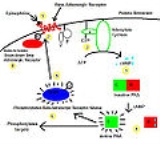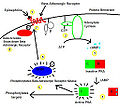
Beta adrenergic receptor kinase
Encyclopedia
Beta adrenergic receptor kinase (also referred to as βARK or BARK) is a serine/threonine intracellular kinase. It is activated by PKA
and its target is the beta adrenergic receptor. It is one method by which the cell will desensitize itself from epinephrine
overstimulation.

Therefore, βARK is a negative feedback enzyme which will prevent over stimulation of the β-adrenergic receptor.
system, which regulates rod cell
function in the retina
, rhodopsin kinase
will phosphorylate serine and threonine residues on the rhodopsin receptor. Similarly to the βARK system, the phosphorylated rhodopsin residues will then bind to arrestin resulting in receptor desensitization.
spans approximately 23 kilobases and is composed of 21 exons interrupted by 20 introns. Exon sizes range from 52 bases (exon 7) to over 1200 bases (exon 21), intron sizes from 68 bases (intron L) to 10.8 kilobases (intron A). The splice sites for donor and acceptor were in agreement with the canonical GT/AG rule. Functional regions of beta ARK are described with respect to their location within the exon-intron organization of the gene. Primer
extension and RNase protection assays suggest a major transcription start site approximately 246 bases upstream of the start ATG. Sequence analysis of the 5'-flanking/promoter region reveals many features characteristic of mammalian housekeeping genes, i.e. the lack of a TATA box
, an absent or nonstandard positioned CAAT box
, high GC content, and the presence of Sp1-binding sites. The extraordinarily high GC content of the 5'-flanking region (> 80%) helps define this region as a CpG island that may be a principal regulator of beta ARK expression.
with PDE6G
, GNAQ
, Src
, PRKCB1
and GIT1
.
CAMP-dependent protein kinase
In cell biology, Protein kinase A refers to a family of enzymes whose activity is dependent on cellular levels of cyclic AMP . PKA is also known as cAMP-dependent protein kinase...
and its target is the beta adrenergic receptor. It is one method by which the cell will desensitize itself from epinephrine
Epinephrine
Epinephrine is a hormone and a neurotransmitter. It increases heart rate, constricts blood vessels, dilates air passages and participates in the fight-or-flight response of the sympathetic nervous system. In chemical terms, adrenaline is one of a group of monoamines called the catecholamines...
overstimulation.
βARK Activation
- (steps 1) Upon stimulation of the Beta adrenergic receptor by epinephrineEpinephrineEpinephrine is a hormone and a neurotransmitter. It increases heart rate, constricts blood vessels, dilates air passages and participates in the fight-or-flight response of the sympathetic nervous system. In chemical terms, adrenaline is one of a group of monoamines called the catecholamines...
, GsHeterotrimeric G protein"G protein" usually refers to the membrane-associated heterotrimeric G proteins, sometimes referred to as the "large" G proteins. These proteins are activated by G protein-coupled receptors and are made up of alpha , beta and gamma subunits, the latter two referred to as the beta-gamma...
will be activated.
- (steps 2 and 3) Gs alpha will then stimulate adenyl cyclase to make cAMPCyclic adenosine monophosphateCyclic adenosine monophosphate is a second messenger important in many biological processes...
.
- (steps 3 through 6) cAMP will then activate cAMP dependent kinase (PKACAMP-dependent protein kinaseIn cell biology, Protein kinase A refers to a family of enzymes whose activity is dependent on cellular levels of cyclic AMP . PKA is also known as cAMP-dependent protein kinase...
), which among other proteins that it acts on, it will phosphorylate serine and threonine residues on βARK.

- (step 7) βARK, itself a serine/threonine kinase, will then phosphorylate serine and threonine resides on the β-adrenergic receptor itself.
- (step 8) This will facilitate Beta-arrestinArrestinArrestins are a small family of proteins important for regulating signal transduction.-Function:Arrestins were first discovered as a part of a conserved two-step mechanism for regulating the activity of G protein-coupled receptors in the visual rhodopsin system by Hermann Kühn and co-workers and...
's binding to the receptor. Additional stimulation by epinephrine will now be unable to activate Gs due to arrestin.
Therefore, βARK is a negative feedback enzyme which will prevent over stimulation of the β-adrenergic receptor.
Other similar systems
In the rhodopsinRhodopsin
Rhodopsin, also known as visual purple, is a biological pigment of the retina that is responsible for both the formation of the photoreceptor cells and the first events in the perception of light. Rhodopsins belong to the G-protein coupled receptor family and are extremely sensitive to light,...
system, which regulates rod cell
Rod cell
Rod cells, or rods, are photoreceptor cells in the retina of the eye that can function in less intense light than can the other type of visual photoreceptor, cone cells. Named for their cylindrical shape, rods are concentrated at the outer edges of the retina and are used in peripheral vision. On...
function in the retina
Retina
The vertebrate retina is a light-sensitive tissue lining the inner surface of the eye. The optics of the eye create an image of the visual world on the retina, which serves much the same function as the film in a camera. Light striking the retina initiates a cascade of chemical and electrical...
, rhodopsin kinase
Rhodopsin kinase
Rhodopsin kinase is a serine/threonine-specific protein kinase involved in phototransduction.-See also:* Rhodopsin* Beta adrenergic receptor kinase* G-protein coupled receptor kinases-External links:...
will phosphorylate serine and threonine residues on the rhodopsin receptor. Similarly to the βARK system, the phosphorylated rhodopsin residues will then bind to arrestin resulting in receptor desensitization.
Protein Structure
The structure of βARK1 consists of a protein of 689 amino acids (79.7 kilodaltons) with a protein kinase catalytic domain that bears greatest sequence similarity to protein kinase C and the cyclic adenosine monophosphate (cyclic AMP)--dependent protein kinase.Gene structure
The geneGene
A gene is a molecular unit of heredity of a living organism. It is a name given to some stretches of DNA and RNA that code for a type of protein or for an RNA chain that has a function in the organism. Living beings depend on genes, as they specify all proteins and functional RNA chains...
spans approximately 23 kilobases and is composed of 21 exons interrupted by 20 introns. Exon sizes range from 52 bases (exon 7) to over 1200 bases (exon 21), intron sizes from 68 bases (intron L) to 10.8 kilobases (intron A). The splice sites for donor and acceptor were in agreement with the canonical GT/AG rule. Functional regions of beta ARK are described with respect to their location within the exon-intron organization of the gene. Primer
Primer (molecular biology)
A primer is a strand of nucleic acid that serves as a starting point for DNA synthesis. They are required for DNA replication because the enzymes that catalyze this process, DNA polymerases, can only add new nucleotides to an existing strand of DNA...
extension and RNase protection assays suggest a major transcription start site approximately 246 bases upstream of the start ATG. Sequence analysis of the 5'-flanking/promoter region reveals many features characteristic of mammalian housekeeping genes, i.e. the lack of a TATA box
TATA box
The TATA box is a DNA sequence found in the promoter region of genes in archaea and eukaryotes; approximately 24% of human genes contain a TATA box within the core promoter....
, an absent or nonstandard positioned CAAT box
CAAT box
In molecular biology, a CCAAT box is a distinct pattern of nucleotides with GGCCAATCT consensus sequence that occur upstream by 75-80 bases to the initial transcription site. The CAAT box signals the binding site for the RNA transcription factor, and is typically accompanied by a conserved...
, high GC content, and the presence of Sp1-binding sites. The extraordinarily high GC content of the 5'-flanking region (> 80%) helps define this region as a CpG island that may be a principal regulator of beta ARK expression.
Interactions
Beta adrenergic receptor kinase has been shown to interactProtein-protein interaction
Protein–protein interactions occur when two or more proteins bind together, often to carry out their biological function. Many of the most important molecular processes in the cell such as DNA replication are carried out by large molecular machines that are built from a large number of protein...
with PDE6G
PDE6G
Retinal rod rhodopsin-sensitive cGMP 3',5'-cyclic phosphodiesterase subunit gamma is an enzyme that in humans is encoded by the PDE6G gene.-Interactions:PDE6G has been shown to interact with Beta adrenergic receptor kinase and Src.-External links:...
, GNAQ
GNAQ
Guanine nucleotide-binding protein G subunit alpha is a protein that in humans is encoded by the GNAQ gene.-Interactions:GNAQ has been shown to interact with Sodium-hydrogen antiporter 3 regulator 1, RIC8A, RGS16, Beta adrenergic receptor kinase, RGS4 and Bruton's tyrosine kinase.-Further reading:...
, Src
Src (gene)
Proto-oncogene tyrosine-protein kinase Src is an enzyme that in humans is encoded by the SRC gene.Src is a proto-oncogene encoding a tyrosine kinase originally discovered by J. Michael Bishop and Harold E. Varmus, for which they won the 1989 Nobel Prize in Physiology or Medicine. It belongs to a...
, PRKCB1
PRKCB1
Protein kinase C beta type is an enzyme that in humans is encoded by the PRKCB gene..-Interactions:PRKCB1 has been shown to interact with RIPK4, Beta adrenergic receptor kinase, PDLIM5 and GNB2L1.-Further reading:-See also:*Protein kinase C...
and GIT1
GIT1
ARF GTPase-activating protein GIT1 is an enzyme that in humans is encoded by the GIT1 gene.GIT1 contains an ARFGAP domain, Anykrin repeats, and a GRK-interacting domain. The Arf-GAP domain, which enables it to act as a GTPase activating protein for the Arf family of GTPases, has been shown to be...
.

